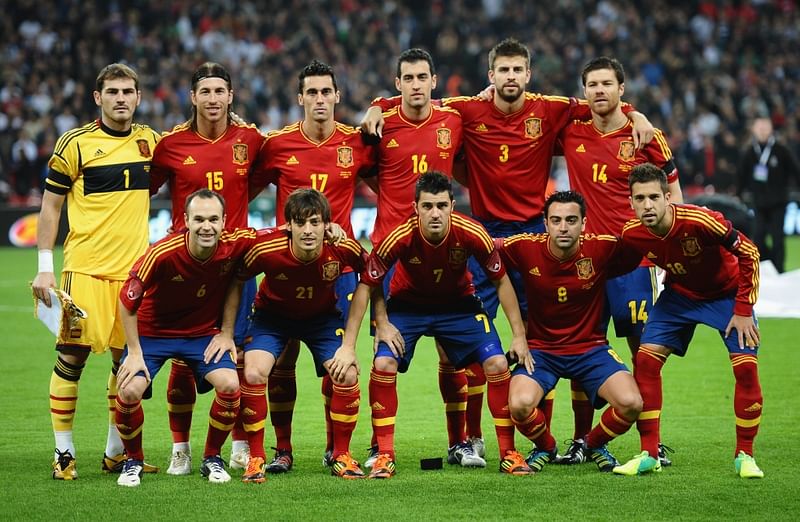
The evolution of La Furia Roja: Spanish national team moving out of the shadow of Barcelona and Real Madrid
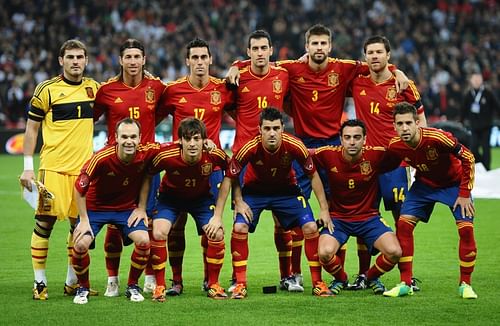
In the final of Euro 2012, Iker Casillas, Alvaro Arbeloa, Gerard Pique, Sergio Ramos, Jordi Alba, Sergio Busquets, Xavi Hernandez, Xabi Alonso, Francesc Fabregas, Andres Iniesta and David Silva walked out to meet Italy in what would turn out to be the last great performance of a side that had enthralled the world with its possession-obsessed dominance and the magisterial beauty of the passing carousel that was its midfield.
From 2008-12, for four long years, this Spanish side had ruled the world of football with an iron fist, albeit clad in the must seductively deceptive velvet glove.
The line-up that day was as much a testament to the stranglehold Barcelona and Real Madrid had in Spain as it was homage to the tiki-taka philosophy – a philosophy that had made Barcelona arguably the greatest footballing side of the new millennium. Of the 11, all but two had played their football the preceding season with one of the two great clubs – David Silva plied his trade in the north of England with Manchester City, while Jordi Alba did his thing at Valencia.
Alba though had just transferred to Barcelona before the Euros started, so technically, there was only ONE non-Barca, non-Madrid player starting that night. It was the same case two years earlier in South Africa, when the only non-‘big two’ starter in the World Cup final was Joan Capdevila (then of Villarreal, currently of North East United!).
The dominance of Barcelona and Madrid
The influence the two great clubs have had over the game in Spain is impossibly immense – in the 85 years of professional football in the nation, one of these two have finished in the top three in all but seven seasons, and all of those were pre-1950. The other great Madrid side Atlético, the great Basque club Athletic Bilbao (trivia - there was a time in Spain when 80% of the professionals in the league were Basques! – now it’s less than 10%) and Valencia have had their moments, but those seem like distant memories now.

The incredible Barcelona team of 2011 – with their Champions League trophy
Between 2004-05 and 2012-13, Barcelona won six titles and Madrid three. And apart from one year (2007-08), they finished one-two with no other realistic contender for either spot. The Valencia team that finished third three consecutive seasons during that period finished at least 25 odd points adrift each time.
It’s interesting that the one year where a club (Villarreal) managed to split the two great rivals was the year that started off this modern era of La Furia’s dominance. The yellow submarines contributed two players to that starting 11 for the Euro ’08 final (Capdevila and the Brazilian born midfield enforcer Marcos Senna) – an 11 which also included Silva (then of Valencia), Fabregas (Arsenal’s all and all at the time) and Fernando Torres (at his Liverpool-wowing, terrifying best). The rest, as ever, were from the “big two”.
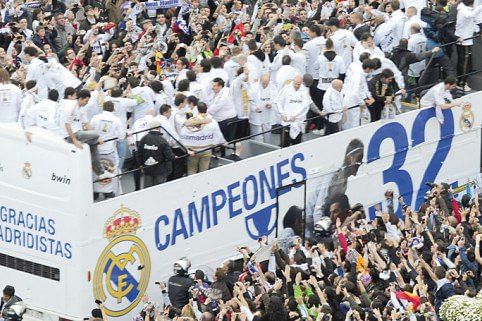
The 2012 Real Madrid side with their record 32nd La Liga title
From then on though, through WC ‘10 and Euro ’12, the Castilian and Catalan clubs utterly dominated the national side as they embarked on their tryst with history. Representatives of clubs like Bilbao (Llorente), Malaga (Cazorla) and Valencia (Mata) – among others – would make the squad, but rarely would any of them lay claim to a starting berth in a major match.
Change is inevitable – and La Furia is no exception
The sustained success of sides often leads to managers and supporters convincing themselves that they can go on forever – the same personnel, the same styles, the same everything. Long story short, they can’t. No matter how good you are, no matter how dominant, sooner or later evolution will catch up with you – this fundamental truth of nature is equally applicable to sports teams.
Spain learnt this the hard way this summer – in their opening World Cup game against the Dutch, the only major changes that Vincent Del Bosque had made to his Euro ‘12 winning outfit/starting 11 was the inclusion of the excellent Cesar Azpilicueta of Chelsea at right back and the human battering ram that is Diego Costa upfront. The naturalized Brazil-born striker wasn’t too comfortable playing the role that David Villa had so magnificently done over the past few years, and it showed that night.
Combine that with the ageing legs of Alonso and Xavi, and the team lacked that extra bit of ‘oomph’ it had always been able to turn on at a moment’s notice. They would go on to be thrashed by the Arjen Robben-inspired Dutch and would suffer the ignominy of being bundled out at the group stage.
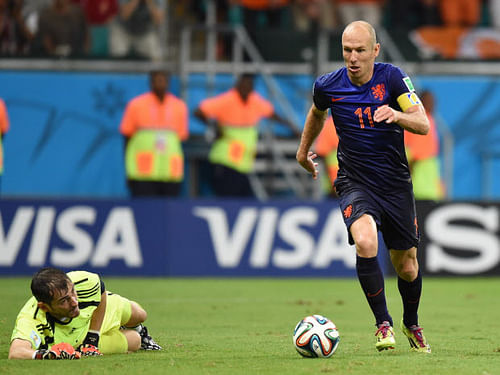
What happened in Brazil is history – and it should stay there for the Iberians. All this talk of the end of Spain as a footballing power and the death of tiki-taka is as foolish as it is premature. For Spain are too good a footballing nation to let one setback (as big as it was) throw them off the heights they have struggled so hard to reach. From perennially entertaining losers to champions who could get results with the minimum of fuss – it has been a long journey.
They will, however, have to accept that times are a-changing. Last year Atlético bulldozed their way past the hegemony of the big two to lay claim to their first title in nearly 20 years. It was a remarkable feat and the impact it has had on the national team cannot be overlooked – especially in the intriguing case of Diego Costa, whose sheer bossing of La Liga and the Champions league forced Del Bosque and the Spanish football federation to take notice and fight Brazil for his services.
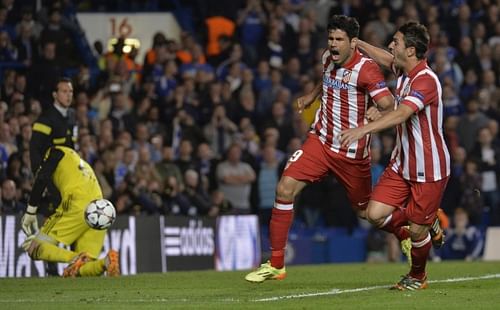
Diego Costa hasnt shone yet for Spain – but there is no denying his quality. Seen here celebrating eliminating his current employers (chelsea) out of the UCL
However, the Word Cup failure showed that a token acknowledgment of the need for change is hardly enough. And with the (international) retirements of the great midfield maestros Xavi and Xabi Alonso, Spain have an opportunity to make some substantial changes.
Rise of the ‘other league’ and the non-residential Spaniards
Until Atlético came along last year, over the last 10-odd years it really has felt like Real Madrid and Barcelona have been playing in a league of their own. But this year it seems different and along with Atléti, Valencia have shown great promise early in the season. More pertinently for the national team, it’s the Spaniards in these teams that have been showing great form and are driving their teams onwards.
That’s not all though. The dominance of the technically brilliant Spaniards in leagues outside their home country has also risen to an extent that to ignore it would be extremely foolhardy.
These two truths – the empowering of other ‘forgotten’ clubs and the increasing dominance of Spaniards outside their country – could see the end of an era when Barca and Madrid have had a virtual death grip over La Furia Roja. And that may just be for the best of the team.
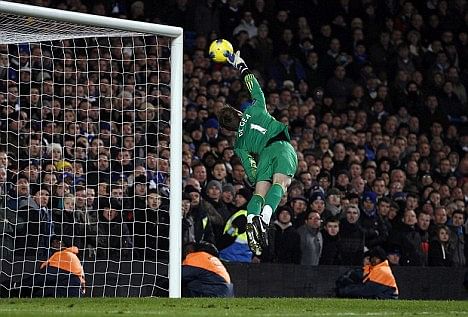
In goal, the best Spaniard in the game currently is undoubtedly David De Gea of Manchester United – the majestic Iker Casillas has been a great captain and an incredible goalkeeper, but seeing him struggle for club and country over the past couple of seasons has been painful to watch.
Cesar Azpilicueta has shown such great form with Chelsea that it would be impossible to leave him out – either at right back at the expense of Madrid’s Carvajal, or at left at the expense of Barca’s Alba. While Pique and Ramos may seem the best centre-back pairing the nation can muster, the recent regression of Pique and the great form shown by Javi Martinez (who has been converted from a defensive midfielder to ball playing centre-back by that perma-tinkering genius Pep Guardiola) may just mean that the defence could contain two non-‘big two’ figures.
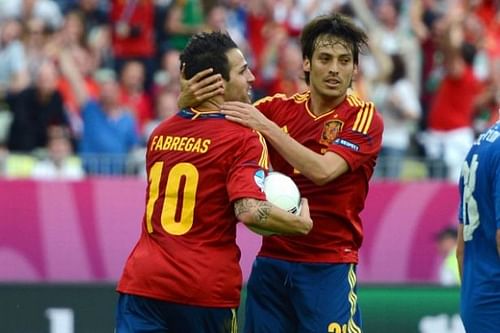
In midfield, while Sergio Busquets and Andres Iniesta remain integral and the magic of Isco is undeniable (and should be better recognised), the growth of the wonderfully tenacious Koke at Atlético and the incredible talent of Thiago Alacantra (at Bayern Munich these days) have become as difficult to overlook as the undoubted match-winning qualities of David Silva and Fabregas (two of the best playmakers in the world, anywhere, right now). With Raul Garcia (Atlético), Bernat (Valencia) and Ander Iturraspe (Athletic Bilbao) coming into their own with their club sides, the midfield has a more open feel to it than has been seen for ages.
The attack at present is utterly dominated by non ‘big two’ representatives – Costa has continued his scintillating form with Chelsea while Valencia have thrown up two delightful talents in the form of the delightful Raul-esque goal monger Francisco ‘Paco’ Alcacer and the pacy inverted winger, Rodrigo Moreno.
It is this sheer spread of talent that makes Spain such a wonderful footballing nation. And an openness to look at these players – players outside Real Madrid and Barcelona, players with a point to prove – and repose trust in them may just see the revitalization of the great Furia Roja.